Input interpretation

NaOH sodium hydroxide + B(OH)_3 boric acid ⟶ H_2O water + BNaO_2 sodium metaborate
Balanced equation
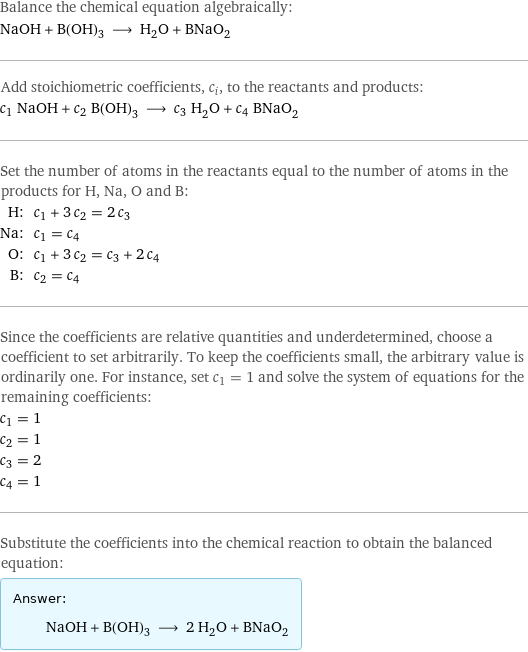
Balance the chemical equation algebraically: NaOH + B(OH)_3 ⟶ H_2O + BNaO_2 Add stoichiometric coefficients, c_i, to the reactants and products: c_1 NaOH + c_2 B(OH)_3 ⟶ c_3 H_2O + c_4 BNaO_2 Set the number of atoms in the reactants equal to the number of atoms in the products for H, Na, O and B: H: | c_1 + 3 c_2 = 2 c_3 Na: | c_1 = c_4 O: | c_1 + 3 c_2 = c_3 + 2 c_4 B: | c_2 = c_4 Since the coefficients are relative quantities and underdetermined, choose a coefficient to set arbitrarily. To keep the coefficients small, the arbitrary value is ordinarily one. For instance, set c_1 = 1 and solve the system of equations for the remaining coefficients: c_1 = 1 c_2 = 1 c_3 = 2 c_4 = 1 Substitute the coefficients into the chemical reaction to obtain the balanced equation: Answer: | | NaOH + B(OH)_3 ⟶ 2 H_2O + BNaO_2
Structures

+ ⟶ +
Names

sodium hydroxide + boric acid ⟶ water + sodium metaborate
Reaction thermodynamics
Enthalpy
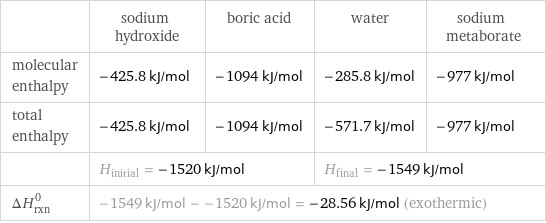
| sodium hydroxide | boric acid | water | sodium metaborate molecular enthalpy | -425.8 kJ/mol | -1094 kJ/mol | -285.8 kJ/mol | -977 kJ/mol total enthalpy | -425.8 kJ/mol | -1094 kJ/mol | -571.7 kJ/mol | -977 kJ/mol | H_initial = -1520 kJ/mol | | H_final = -1549 kJ/mol | ΔH_rxn^0 | -1549 kJ/mol - -1520 kJ/mol = -28.56 kJ/mol (exothermic) | | |
Gibbs free energy
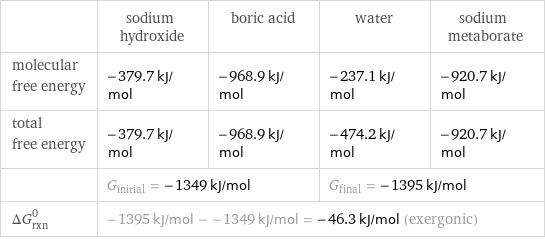
| sodium hydroxide | boric acid | water | sodium metaborate molecular free energy | -379.7 kJ/mol | -968.9 kJ/mol | -237.1 kJ/mol | -920.7 kJ/mol total free energy | -379.7 kJ/mol | -968.9 kJ/mol | -474.2 kJ/mol | -920.7 kJ/mol | G_initial = -1349 kJ/mol | | G_final = -1395 kJ/mol | ΔG_rxn^0 | -1395 kJ/mol - -1349 kJ/mol = -46.3 kJ/mol (exergonic) | | |
Equilibrium constant
![Construct the equilibrium constant, K, expression for: NaOH + B(OH)_3 ⟶ H_2O + BNaO_2 Plan: • Balance the chemical equation. • Determine the stoichiometric numbers. • Assemble the activity expression for each chemical species. • Use the activity expressions to build the equilibrium constant expression. Write the balanced chemical equation: NaOH + B(OH)_3 ⟶ 2 H_2O + BNaO_2 Assign stoichiometric numbers, ν_i, using the stoichiometric coefficients, c_i, from the balanced chemical equation in the following manner: ν_i = -c_i for reactants and ν_i = c_i for products: chemical species | c_i | ν_i NaOH | 1 | -1 B(OH)_3 | 1 | -1 H_2O | 2 | 2 BNaO_2 | 1 | 1 Assemble the activity expressions accounting for the state of matter and ν_i: chemical species | c_i | ν_i | activity expression NaOH | 1 | -1 | ([NaOH])^(-1) B(OH)_3 | 1 | -1 | ([B(OH)3])^(-1) H_2O | 2 | 2 | ([H2O])^2 BNaO_2 | 1 | 1 | [BNaO2] The equilibrium constant symbol in the concentration basis is: K_c Mulitply the activity expressions to arrive at the K_c expression: Answer: | | K_c = ([NaOH])^(-1) ([B(OH)3])^(-1) ([H2O])^2 [BNaO2] = (([H2O])^2 [BNaO2])/([NaOH] [B(OH)3])](../image_source/5e7a875038a9e7c8b04678e73febfd04.png)
Construct the equilibrium constant, K, expression for: NaOH + B(OH)_3 ⟶ H_2O + BNaO_2 Plan: • Balance the chemical equation. • Determine the stoichiometric numbers. • Assemble the activity expression for each chemical species. • Use the activity expressions to build the equilibrium constant expression. Write the balanced chemical equation: NaOH + B(OH)_3 ⟶ 2 H_2O + BNaO_2 Assign stoichiometric numbers, ν_i, using the stoichiometric coefficients, c_i, from the balanced chemical equation in the following manner: ν_i = -c_i for reactants and ν_i = c_i for products: chemical species | c_i | ν_i NaOH | 1 | -1 B(OH)_3 | 1 | -1 H_2O | 2 | 2 BNaO_2 | 1 | 1 Assemble the activity expressions accounting for the state of matter and ν_i: chemical species | c_i | ν_i | activity expression NaOH | 1 | -1 | ([NaOH])^(-1) B(OH)_3 | 1 | -1 | ([B(OH)3])^(-1) H_2O | 2 | 2 | ([H2O])^2 BNaO_2 | 1 | 1 | [BNaO2] The equilibrium constant symbol in the concentration basis is: K_c Mulitply the activity expressions to arrive at the K_c expression: Answer: | | K_c = ([NaOH])^(-1) ([B(OH)3])^(-1) ([H2O])^2 [BNaO2] = (([H2O])^2 [BNaO2])/([NaOH] [B(OH)3])
Rate of reaction
![Construct the rate of reaction expression for: NaOH + B(OH)_3 ⟶ H_2O + BNaO_2 Plan: • Balance the chemical equation. • Determine the stoichiometric numbers. • Assemble the rate term for each chemical species. • Write the rate of reaction expression. Write the balanced chemical equation: NaOH + B(OH)_3 ⟶ 2 H_2O + BNaO_2 Assign stoichiometric numbers, ν_i, using the stoichiometric coefficients, c_i, from the balanced chemical equation in the following manner: ν_i = -c_i for reactants and ν_i = c_i for products: chemical species | c_i | ν_i NaOH | 1 | -1 B(OH)_3 | 1 | -1 H_2O | 2 | 2 BNaO_2 | 1 | 1 The rate term for each chemical species, B_i, is 1/ν_i(Δ[B_i])/(Δt) where [B_i] is the amount concentration and t is time: chemical species | c_i | ν_i | rate term NaOH | 1 | -1 | -(Δ[NaOH])/(Δt) B(OH)_3 | 1 | -1 | -(Δ[B(OH)3])/(Δt) H_2O | 2 | 2 | 1/2 (Δ[H2O])/(Δt) BNaO_2 | 1 | 1 | (Δ[BNaO2])/(Δt) (for infinitesimal rate of change, replace Δ with d) Set the rate terms equal to each other to arrive at the rate expression: Answer: | | rate = -(Δ[NaOH])/(Δt) = -(Δ[B(OH)3])/(Δt) = 1/2 (Δ[H2O])/(Δt) = (Δ[BNaO2])/(Δt) (assuming constant volume and no accumulation of intermediates or side products)](../image_source/c40e55833f9b8642bd7fc17440dac27e.png)
Construct the rate of reaction expression for: NaOH + B(OH)_3 ⟶ H_2O + BNaO_2 Plan: • Balance the chemical equation. • Determine the stoichiometric numbers. • Assemble the rate term for each chemical species. • Write the rate of reaction expression. Write the balanced chemical equation: NaOH + B(OH)_3 ⟶ 2 H_2O + BNaO_2 Assign stoichiometric numbers, ν_i, using the stoichiometric coefficients, c_i, from the balanced chemical equation in the following manner: ν_i = -c_i for reactants and ν_i = c_i for products: chemical species | c_i | ν_i NaOH | 1 | -1 B(OH)_3 | 1 | -1 H_2O | 2 | 2 BNaO_2 | 1 | 1 The rate term for each chemical species, B_i, is 1/ν_i(Δ[B_i])/(Δt) where [B_i] is the amount concentration and t is time: chemical species | c_i | ν_i | rate term NaOH | 1 | -1 | -(Δ[NaOH])/(Δt) B(OH)_3 | 1 | -1 | -(Δ[B(OH)3])/(Δt) H_2O | 2 | 2 | 1/2 (Δ[H2O])/(Δt) BNaO_2 | 1 | 1 | (Δ[BNaO2])/(Δt) (for infinitesimal rate of change, replace Δ with d) Set the rate terms equal to each other to arrive at the rate expression: Answer: | | rate = -(Δ[NaOH])/(Δt) = -(Δ[B(OH)3])/(Δt) = 1/2 (Δ[H2O])/(Δt) = (Δ[BNaO2])/(Δt) (assuming constant volume and no accumulation of intermediates or side products)
Chemical names and formulas
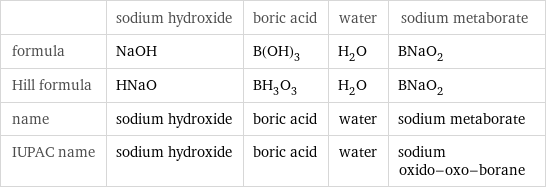
| sodium hydroxide | boric acid | water | sodium metaborate formula | NaOH | B(OH)_3 | H_2O | BNaO_2 Hill formula | HNaO | BH_3O_3 | H_2O | BNaO_2 name | sodium hydroxide | boric acid | water | sodium metaborate IUPAC name | sodium hydroxide | boric acid | water | sodium oxido-oxo-borane
Substance properties
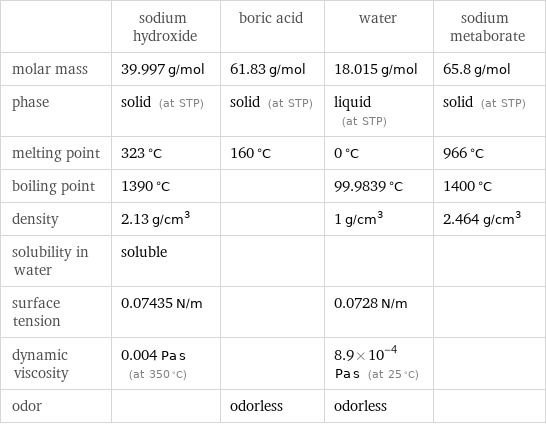
| sodium hydroxide | boric acid | water | sodium metaborate molar mass | 39.997 g/mol | 61.83 g/mol | 18.015 g/mol | 65.8 g/mol phase | solid (at STP) | solid (at STP) | liquid (at STP) | solid (at STP) melting point | 323 °C | 160 °C | 0 °C | 966 °C boiling point | 1390 °C | | 99.9839 °C | 1400 °C density | 2.13 g/cm^3 | | 1 g/cm^3 | 2.464 g/cm^3 solubility in water | soluble | | | surface tension | 0.07435 N/m | | 0.0728 N/m | dynamic viscosity | 0.004 Pa s (at 350 °C) | | 8.9×10^-4 Pa s (at 25 °C) | odor | | odorless | odorless |
Units
